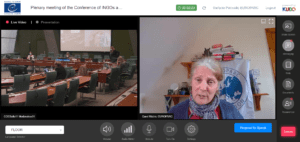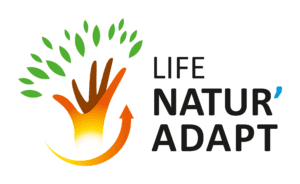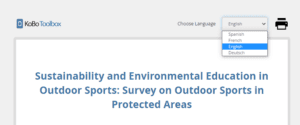Conference of International NGO’s – EUROPARC wins vote for new “Environment” committee
Gerhard Ermischer take over as newly elected President of the Conference of INGOs from Anna Rurka
EUROPARC has enjoyed International Observer (INGO)status with the Council of Europe since 2013, and has been an observer to the Bern Convention since the 1970s! As an INGO we are a member of the conference of INGOs, which can offer advice, support and comment to the other formal bodies in the Council of Europe.
A new committee for the Council of Europe!
Last year saw much welcome reforms to the Conference of INGOs paving the way for greater diversity and participation. There are few environmental NGOs with INGO status and hence topics around biodiversity loss, climate change and health rarely had space, despite the importance of the Bern Convention within the Council of Europe. EUROPARC therefore took the opportunity to propose a new thematic committee, working with colleagues in the heritage sector within the Conference of INGO’s to address these critical issues.
Voting for the president, vice president and standing committee of the conference as well as those for the creation of new committees took place this week.
EUROPARC is pleased to announce we were successful in that vote and our Executive Director was elected to chair this new Environment, Climate Change, Heritage and Health committee.
With the foundations of the Council of Europe being Human Rights, Democracy and the Rule of law, we want to bring the environmental consciences to these issue as well as highlight the relevance of these to the biodiversity, climate change and health debates.
With excellent support from CivilScape, European Association of Archaeologists EAA, European Environment Bureau, European Confederation of Youth Club Organisations (ECYC), European Council of Doctoral Candidates and Junior Researchers, and Friends of the Earth/ProNatura (who are EUROPARC members), we have formed the core of the committee and are yet seeking others to join us.
We will of course bring the experience and voice of our members into this committee, especially those members (i.e. those outside the EU27) for whom the Council of Europe and the Bern Convention is our main convening platform for matters of nature conservation.
Work will begin now to bring more members of the committee on board, but we will be looking to bring the issues from the nature conservation world, into the decision -making of the Council of Europe.

Executive Director Carol Ritchie highlighted the importance and need for a new committee addressing Environment, Climate Change, Heritage and Health in the Conference.
The conference voted for the committee with a large majority and MS Ritchie as it chair
European State of the Climate 2020 is now out!
Photo by Lucian Potlog from Pexels
This comprehensive review of last year’s climate data published by the European Commission, highlights that in 2020, greenhouse gas concentrations have not decreased. Average annual temperatures kept soaring and precipitation patterns have been disrupted. “Storm Alex”, the extreme climate event that left two valleys of Parc National du Mercantour in France in complete disarray is a sad but plain example.
Our most recent work shows that Protected Areas and the habitats, species and communities they shelter are at risk. Yet, as the best remnants of European nature and healthy socio-ecosystems, they play an important and ongoing part in climate regulation and mitigation. They offer natural solutions to mitigate and adapt to climate change negative effects and build a nature-inclusive climate-resilient society.
The European State of the Climate 2020
For the fourth time, the European State of the Climate (ESOTC) report was released. It is compiled by the Copernicus Climate Change Services (C3S), which is implemented by the European Centre for Medium-Range Weather Forecasts (ECMWF) on behalf of the European Commission. The ESOTC provides a detailed analysis of the past calendar year for Europe, as well as a short overview of the global context in 2020 and a focus on the Arctic.
Key Learnings
Many had possibly hoped that due to the COVID-19 crisis, emissions would decrease and allow for “a moment to breath”. The results are sadly underwhelming. Concentrations of greenhouse gases continued to increase and were in fact the highest measured by satellites since the start of observations in 2003. Overall, 2020 was the hottest year on record for Europe. Globally, it was one of the three warmest years ever recorded. Winter in northeastern Europe was exceptionally warm, with an average temperature that was nearly 1.9°C higher than the previous record in 2008. This, for example, resulted in unusually low sea ice cover in the northern part of the Baltic Sea and the Gulf of Finland and very few snow days in the area around the southern Baltic Sea.
Other abnormalities were related to precipitation, where a wetter-than-average winter transitioned into a dry spring in northwest Europe. Persistent dry conditions remained from spring through to autumn across western continual Europe. Additionally, river discharge was at its lowest since 1991 with high fluctuations throughout the year due to storm Alex among others.
The EU Climate Law
Reports like the ESOTC are important indicators for policy makers to help produce a roadmap to achieve their goals. The European Commission’s Green Deal strives to make Europe the first climate-neutral continent by 2050. To achieve that goal, an agreement on the European Climate Law was reached last week. Negotiators from the EU Parliament and Member States agreed to reduce net greenhouse gas emissions by “at least 55%” by 2030, compared to 1990 levels. That objective will therefore also become a legal obligation for the EU and its member states.
Protected Areas network, a keystone of climate-resilient societies
This report is highlighting the urgency to mitigate and adapt to the negative effects of climate change as the trend is not slowing down.
Climate change as well as global nature loss and degradation are currently affecting the very conditions upon which human communities and wildlife depend. Although local and regional assessments are required, Protected Areas are globally vulnerable to climate change. It causes disruptions in ecosystem structures and processes, directly or indirectly impacting species and biodiversity.
Yet, at the same time, Protected Areas offer solutions to tackle those twin challenges. As the best remnants of natural ecosystems, Protected Areas play an important and ongoing part in climate regulation and mitigation. They offer natural solutions and can actively contribute to the implementation, at multiple geopolitical scales, of the EU Biodiversity Strategy for 2030 and the EU strategy on climate change adaptation.
Helping Protected Areas adapt to climate change
As an active partner of LIFE Natur’Adapt, EUROPARC is helping and engaging its community of members to integrate climate change adaptation in their management practices.
With the support of a dedicated task force, EUROPARC is:
- Developing a policy brief for decision makers;
- Organising live exchanges among peers;
- Sharing knowledge and experience, which include the project’s latest results.
You can read all about the LIFE Natur’Adapt project here. If you have any experience or questions, do not hesitate to contact EUROPARC’s project manager, Olivier de Sadeleer [olivier.desadeleer@europarc.org]

You can find the ESOTC report here.
Fill out the survey on Outdoor Sports in Protected Areas
The webinar “Outdoor Sports: Engaging with or using nature?” that took place on 27 April 2021 publicly launched the new ERASMUS+ SEE project. As part of the project, we invite all EUROPARC members to complete the survey – available in 4 languages – on outdoor sports practice in Protected Areas!
Give us your inputs on Outdoor Sports in Protected Areas
In the last EUROPARC Webinar on Outdoor Sports in Protected Areas, we heard inspiring case studies from a variety of speakers. If you missed it, you can watch the recording here. Additionally, the webinar also launched a new ERASMUS+ project: the SEE project – standing for Sustainability and Environmental Education in Outdoor Sports, in which EUROPARC is one of the partners.
In the initial phase of the project, EUROPARC created a survey to collect inputs from Protected Areas across Europe. From the survey, we hope to learn about the various impacts of outdoor sports in nature and innovative practices to effectively manage them.
>>>>>>GO TO THE SURVEY<<<<<<
We invite EUROPARC members to take part and fill out the survey, as it will provide valuable inputs for a future toolkit for outdoor sport trainers and educators!
Who is the survey for?
The survey is addressed to Parks and Protected Area managers or other professionals who have management authority over a publicly accessible natural area where outdoor sports take place. That includes all sorts of Protected Areas including Periurban Parks, Marine Protected Areas, Biosphere reserves, National or Regional Parks etc. In case your institution is managing more than one Protected Area, we would like to kindly ask you to submit several surveys – one per each Protected Area.
A survey addressed to the Outdoor Sports sector will follow later and will be prepared by other SEE project partners.
Available in 4 languages!
The questionnaire is available in 4 languages (English, French, German and Spanish), it should take about 15 minutes and is open until the end of May. We might get back to some of the respondents later to follow up – for example if you share an interesting case study.

You can choose the language in the drop down menu in the top right corner.
The SEE project will then analyse the data and its outcomes should contribute to the preparation of a toolkit for outdoor sports trainers and educators in order to ensure a more sustainable, respectful and enjoyable outdoor sport experience.
We look forward to receiving your inputs!
Read more about the SEE project here.
If you have any questions, do not hesitate to contact michaela.kozminova@europarc.org .

Next Webinar: Why and How to Make Nature More Accessible?
Photo by Alise Lūse
Join EUROPARC’s next webinar on accessibility in Protected Areas!
- Why and How to Make Nature More Accessible?
- 7th of May, 13:00h CET
- Free – registration is needed
National Parks, nature heritage sites and symbolic landscapes are our national values and contribute to the quality of life. They are also an important source for environmental education, recreation, and tourism. But are they accessible for all?
Getting to nature can sometimes be challenging, due to a rocky path surface, a boardwalk being too narrow, too steep, too slippery or due to there being no nature trail at all. This affects not just those with a disability, but also people with temporary injuries, parents with small children, seniors, in fact, the largest part of the population. Adapting the environment and services to all is part of a sustainable development concept and is important, both from the social, as well as the economic perspective.
The aim of this webinar is to highlight why the access to nature becomes more and more present nowadays and what access options should and can be sought. Presenters from Finland, Spain and Latvia will show how being outdoors is linked to the national identity and the pressures the Covid-19 pandemic is putting on nature trails. Additionally, they will present the nature accessibility issue from the user’s point of view and share good practice examples on inclusive nature education and accessibility solutions for nature trails.
Sign up here!
Webinar Programme
By Sanna Kalmari – Accessible Travel Specialist & Travel Blogger, Finland.
Finland and other northern countries are the world’s leading destinations for nature lovers and being outdoors is inseparably connected with the national identity. That is why it’s important to make nature accessible for all, as a basic human right. Many National Parks and nature areas have accessible hiking services that meet the needs of all kinds of hikers and nature enthusiasts, including families and small children, the elderly and the physically challenged. In this presentation we hear how nature can offer meaningful experiences for a wheelchair user, what kind of information a local or a tourist with a disability needs about accessible nature trails and how to promote them.
Don’t stay at home! Accessibility in the Natural Parks Network of the Barcelona Provincial Council.
By Dafne Farré Lladó – Public Use and Environmental Education Technician, Natural Parks Network of Barcelona Provincial Council, Spain.
The Barcelona Provincial Council’s Natural Park Network consists of 12 nature areas of significant landscape, environmental and cultural value. Since 2005–2006, all its programmes, services and infrastructures are being evaluated to guarantee usability for functionally diverse people. Currently, all its school education programmes are inclusive, with adapted teaching materials and resources. At the same time, the network of accessible and practicable itineraries is constantly expanding, and natural parks offer a wide range of rental equipment (handbikes, Joëlettes, directional bars) to guarantee autonomous, safe, and comfortable access to nature for everyone.
Nature accessibility solutions and the promotion of understanding in the Central Baltic Region.
By Alise Lūse – Accessible Nature Tourism & Trails Practitioner, Latvia.
Central Baltic countries are among the top 15 countries with the largest percentage of seniors (65+ of total population of the country) in the world. Latvia, Estonia, and Finland are among the top 5 countries in Europe with the largest disability prevalence. The numbers are constantly expanding through the population growth, medical advances and the ageing process. Nowadays accessibility becomes more and more important and is the key focus of the Central Baltic Programme Project “Nature access to all”. In this presentation the project’s ambitions, main achievements and accessibility solutions will be revealed to share the best practice and encourage nature parks, municipalities and other trail administrators to make step by step improvements in their infrastructure, products and services to facilitate nature access to all.
Let’s talk about it…
All participants will have the opportunity to exchange on the topics discussed and/or ask questions.
